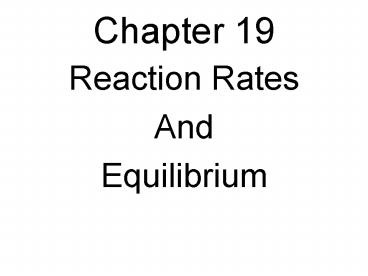Reaction Rates - PowerPoint PPT Presentation
1 / 27
Title:
Reaction Rates
Description:
Chapter 19 Reaction Rates And Equilibrium Rates Measures the speed of change over an interval of time Collision Theory Atoms, ions, and molecules can react to form ... – PowerPoint PPT presentation
Number of Views:428
Avg rating:3.0/5.0
Title: Reaction Rates
1
Chapter 19
- Reaction Rates
- And
- Equilibrium
2
Rates
- Measures the speed of change over an interval of
time
3
Collision Theory
- Atoms, ions, and molecules can react to form
products when they collide with enough kinetic
energy.
4
(No Transcript)
5
Activation Energy
- The minimum amount of energy that particles must
have to react.
6
Transition State
- The point at the peak of the activation energy
where compounds change back to reactants or form
new products.
7
4 Factors affecting Reaction Rates
- 1.Temperature Increase in temperature increase
in KE, w/more KE one has more and harder
collisions causing more product to form
8
2. Concentration
- More molecules means greater chance of collision
resulting in the formation of new products.
9
3. Particle Size(increased surface area)
- The more surface area you have the greater the
chance of collision.
10
4. Catalyst
- A substance that speeds up a reaction without
being used up in that reaction. - Usually written above the yields sign in an
equation.
11
(No Transcript)
12
Inhibitors
- Works against the catalyst.
13
Reversible Reactions
- The reaction occurs in both directions at the
same time.
14
(No Transcript)
15
2 SO2 O2 2 SO3
16
Chemical Equilibrium
- A state at which the forward and reverse reaction
occur at the same rate.
17
DOES NOT MEAN
- Same amount of product and reactant formed.
18
(No Transcript)
19
LeChatliers Principle
- If stress is applied to a system in dynamic
equilibrium, the system changes to relieve the
stress.
20
Concentration
- Increasing the concentration will always change
the equilibrium away from the increased
concentration.
21
H2CO3 CO2 H2O
22
Temperature
- Equilibrium shifts in the direction that absorbs
the heat
23
2 SO2 O2 2 SO3 Heat
24
Pressure (in gasses)
- Only affects equilibrium if there is an unequal
of moles. Equilibrium moves to the side w/less
moles.
25
K(eq) Equilibrium Constant
- The lower case letters of moles of that
compound - aA bB cC dD
26
K(eq)
Cc x Dd
Aa x Bb
27
K(eq) Equilibrium Constant
- It shows whether products or reactants are
favored in the reaction. - K(eq) gt 1 Products are favored
- K(eq) lt 1 Reactants are favored































